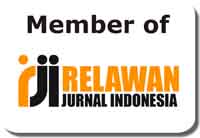Personal Name and Lineage: Patronym of Arab Descent in Indonesia
Abstract
Research on patronym recently focuses only on the names of European and Russian communities. The patronyms that appear are limited to the names of the boys who use his father’s name. Arab descent in Indonesia has a more complex patronymic tradition used for male and female, featuring not only the father’s name but also the grandfather’s name as a patron. To fill the gap, this study aimed to explore the forms and patterns of patronyms in the personal names of Arab descent, especially viewed from gender differences by utilizing the onomastic framework. The dataset was taken from the Pasar Kliwon Subdistrict population data which was retrieved from the Population and Civil Registration Agency of Surakarta City. The biological father’s name is juxtaposed to find out and validate the existence of a patronym in the child’s name. The results showed that of 4,756 Arab descent names, 1,114 people (637 males and 477 females) were found who have personal names containing the names of fathers. Only 150 people (92 males and 58 females) have the name of grandfathers in their names. The names of the father and/or grandfather are generally present after the first name and before the surname. Besides being used to claim community membership, patronyms are also intended to show the lineage and the expression of emotional ties between family members. Patronym among Arab descent in Indonesia presents evidence of how the naming system influences robust patrilineal systems and endogamous marriages.
Keywords
Full Text:
PDFReferences
Aksholakova, A. (2014). Proper name as a clue symbol of identity. Procedia - Social and Behavioral Sciences, 112, 465–471. https://doi.org/10.1016/j.sbspro.2014.01.1190
Anderson, J. M. (2007). The Grammar of Names. Oxford: Oxford University Press. https://doi.org/10.1093/acprof:oso/9780199297412.001.0001
Aribowo, E. K. (2019a). Analisis Bibliometrik Berkala Ilmiah Names: Journal of Onomastics dan Peluang Riset Onomastik di Indonesia. Aksara, 31(1), 91–111. https://doi.org/10.29255/aksara.v31i1.373.91-111
Aribowo, E. K. (2019b). Dataset Nama Keturunan Arab Kecamatan Pasar Kliwon Surakarta. https://doi.org/10.6084/m9.figshare.8293739
Aribowo, E. K. (2020). Supplemental Material for Personal Name and Lineage: Patronym of Arab Descent in Indonesia. figshare. https://doi.org/10.6084/m9.figshare.12628604.v1
Aribowo, E. K., & Almasitoh, U. H. (2019). Disparity of The Arabic Name: The Spotlight on Children of Endogamous and Exogamous Marriages among Hadrami-Arabs in Indonesia. Arabiyat: Jurnal Pendidikan Bahasa Arab Dan Kebahasaaraban, 6(1), 1–17. https://doi.org/10.15408/a.v6i1.9384
Aribowo, E. K., Hadi, S., & Ma’ruf, A. (2019). Similar but Not The Same: How to Identify The Name of Arab Descendant and The Arabic Name of Javanese. Arabi: Journal of Arabic Studies, 4(2), 115–126. https://doi.org/10.24865/ajas.v4i2.154
Aribowo, E. K., & Herawati, N. (2016). Trends in Naming System on Javanese Society: A Shift From Javanese to Arabic. Lingua Cultura, 10(2), 117–122. https://doi.org/10.21512/lc.v10i2.1730
Assagaf, M. H. (2000). Derita Putri-Putri Nabi: Studi Historis Kafa’ah Syarifah. Bandung: Rosda.
Azhari, F., Muttaqien, Z., & Kurdi, S. (2013). Motivasi Perkawinan Endogami pada Komunitas Alawiyyin di Martapura Kabupaten Banjar. Mu’adalah: Jurnal Studi Gender Dan Anak, 1(2), 85–102. Retrieved from http://jurnal.uin-antasari.ac.id/index.php/psj/article/viewFile/677/537
Bahafdulllah, M. H. (2010). Dari Nabi Nuh AS sampai Orang Hadhramaut di Indonesia. Jakarta: Bania Publishing.
Blanar, V. (2009). Proper Names in the Light of Theoretical Onomastics. Bratislava: Matica Slovenská.
Brown, R. P., Carvallo, M., & Imura, M. (2014). Naming Patterns Reveal Cultural Values: Patronyms, Matronyms, and the U.S. Culture of Honor. Personality and Social Psychology Bulletin, 40(2), 250–262. https://doi.org/10.1177/0146167213509840
Colman, F. (2014). The Grammar of Names in Anglo-Saxon England: The Linguistics and Culture of the Old English Onomasticon. Oxford: Oxford University Press.
Jacobsen, F. F. (2007). Marriage Patterns and Social Stratification in Present Hadrami Arab Societies in Central and Eastern Indonesia. Asian Journal of Social Science, 35(4/5), 472–487. https://doi.org/156853107X240305
Kafaabillah, D. (2018). Nama Marga sebagai Identitas Budaya Masyarakat Etnis Arab. Litera: Jurnal Penelitian Bahasa, Sastra, Dan Pengajarannya, 17(2), 175–185. https://doi.org/10.21831/ltr.v17i2.18364
Kotilainen, S. (2011). The Genealogy of Personal Name: Towards a more productive method in historical onomastics. Scandinavian Journal of History, 36(1), 44–64. https://doi.org/10.1080/03468755.2010.542661
Lawson, E. D. (2016). Personal Naming Systems (C. Hough, Ed.). Oxford University Press. https://doi.org/10.1093/oxfordhb/9780199656431.013.31
Mateos, P., & Tucker, K. (2008). Forenames and Surnames in Spain in 2004. Names, 56(3), 165–184. https://doi.org/10.1179/175622708X332860
Microsoft. (2018). Microsoft Excel for Mac. Retrieved from https://products.office.com/en-us/mac/microsoft-office-for-mac
Palsson, G., & Pálsson, G. (2014). Personal Names: Embodiment, Differentiation, Exclusion, and Belonging. Science, Technology & Human Values, 39(4), 618–630. https://doi.org/10.1177/0162243913516808
Poulain, M., Foulon, M., Degioanni, A., & Darlu, P. (2000). Flemish Immigration in Wallonia and in France: Patronyms as Data. The History of the Family, 5(2), 227–241. https://doi.org/10.1016/S1081-602X(00)00035-X
Rahmaniah, S. E. (2014). Multikulturalisme dan Hegemoni Politik Pernikahan Endogami: Implikasi dalam Dakwah Islam. Walisongo, 22(2), 433–456. https://doi.org/10.21580/WS.2014.22.2.273
Restall, M. (1998). The Ties That Bind: Social Cohesion and the Yucatec Maya Family. Journal of Family History, 23(4), 355–381. https://doi.org/10.1177/036319909802300402
Sahayu, W. (2014). Penanda Jenis Kelamin pada Nama Jawa dan Nama Jerman. Litera: Jurnal Penelitian Bahasa, Satra, Dan Pengajarannya, 13(2), 338–348. https://doi.org/10.21831/ltr.v13i2.5251
Sakallı, E. (2016). New Trends in Name-Giving in Turkey. Вопросы Ономастики, 13(1), 171–177. https://doi.org/10.15826/vopr_onom.2016.13.1.010
Shahab, Y. Z., Shahab, & Zaki, Y. (2014). Sistim Kekerabatan sebagai Katalisator Peran Ulama Keturunan Arab di Jakarta. Antropologi Indonesia, 29(2), 123–141. https://doi.org/10.7454/ai.v29i2.3532
Suharyo. (2013). Pola Nama Masyarakat Keturunan Tionghoa. Humanika, 18(2), 1–10. Retrieved from https://ejournal.undip.ac.id/index.php/humanika/article/view/5952
Tableau. (2018). Tableau Desktop Professional Edition. Retrieved from https://www.tableau.com/products/desktop
Tremblay, M. (2017). Intergenerational Analysis of Patronymic Transformations in the Quebec (Canada) Population Since the Seventeenth Century. Names, 65(1), 26–35. https://doi.org/10.1080/00277738.2016.1223122
van Langendonck, W. (2007). Theory and Typology of Proper Names. Berlin: Mouton de Gruyter. https://doi.org/10.1515/LING.2009.042
Walker, J. A. (2013). Variation analysis. In R. J. Podesva & D. Sharma (Eds.), Research Methods in Linguistics (pp. 440–459). Cambridge: Cambridge University Press. https://doi.org/10.1017/CBO9781139013734.023
Yahya. (2002). Arab Keturunan di Indonesia: Tinjauan Sosio-Historis tentang Arab Keturunan dan Perannya dalam Kehidupan Masyarakat Indonesia. Ulul Albab: Jurnal Studi Islam, 4(2), 113–126. https://doi.org/10.18860/ua.v4i2.6129
DOI: http://dx.doi.org/10.31332/lkw.v0i0.2006
Copyright (c) 2020 Eric Kunto Aribowo

This work is licensed under a Creative Commons Attribution-ShareAlike 4.0 International License.
Langkawi: Journal of The Association for Arabic and English indexed by:



















.png)
.png)

.png)
2.png)








